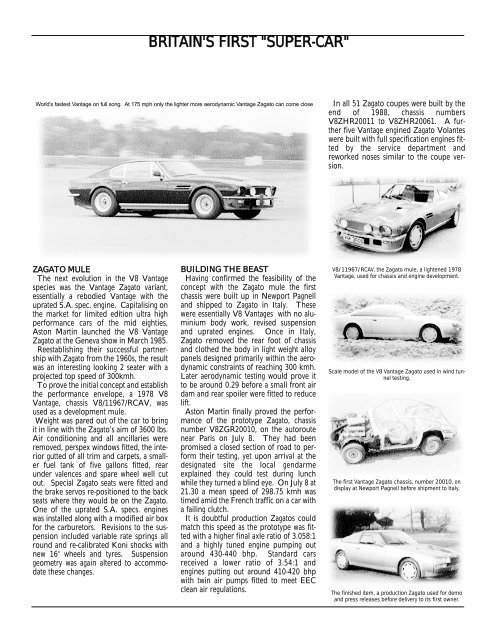BRITAIN'S FIRST "SUPER-CAR" - The Aston Martin V8 Vantage ...
BRITAIN'S FIRST "SUPER-CAR" - The Aston Martin V8 Vantage ...
BRITAIN'S FIRST "SUPER-CAR" - The Aston Martin V8 Vantage ...
You also want an ePaper? Increase the reach of your titles
YUMPU automatically turns print PDFs into web optimized ePapers that Google loves.
<strong>BRITAIN'S</strong> <strong>FIRST</strong> "<strong>SUPER</strong>-CAR"<br />
World’s fastest <strong>Vantage</strong> on full song. At 175 mph only the lighter more aerodynamic <strong>Vantage</strong> Zagato can come close<br />
ZAGATO MULE<br />
<strong>The</strong> next evolution in the <strong>V8</strong> <strong>Vantage</strong><br />
species was the <strong>Vantage</strong> Zagato variant,<br />
essentially a rebodied <strong>Vantage</strong> with the<br />
uprated S.A. spec. engine. Capitalising on<br />
the market for limited edition ultra high<br />
performance cars of the mid eighties,<br />
<strong>Aston</strong> <strong>Martin</strong> launched the <strong>V8</strong> <strong>Vantage</strong><br />
Zagato at the Geneva show in March 1985.<br />
Reestablishing their successful partnership<br />
with Zagato from the 1960s, the result<br />
was an interesting looking 2 seater with a<br />
projected top speed of 300kmh.<br />
To prove the initial concept and establish<br />
the performance envelope, a 1978 <strong>V8</strong><br />
<strong>Vantage</strong>, chassis <strong>V8</strong>/11967/RCAV, was<br />
used as a development mule.<br />
Weight was pared out of the car to bring<br />
it in line with the Zagato’s aim of 3600 lbs.<br />
Air conditioning and all ancillaries were<br />
removed, perspex windows fitted, the interior<br />
gutted of all trim and carpets, a smaller<br />
fuel tank of five gallons fitted, rear<br />
under valences and spare wheel well cut<br />
out. Special Zagato seats were fitted and<br />
the brake servos re-positioned to the back<br />
seats where they would be on the Zagato.<br />
One of the uprated S.A. specs. engines<br />
was installed along with a modified air box<br />
for the carburetors. Revisions to the suspension<br />
included variable rate springs all<br />
round and re-calibrated Koni shocks with<br />
new 16" wheels and tyres. Suspension<br />
geometry was again altered to accommodate<br />
these changes.<br />
BUILDING THE BEAST<br />
Having confirmed the feasibility of the<br />
concept with the Zagato mule the first<br />
chassis were built up in Newport Pagnell<br />
and shipped to Zagato in Italy. <strong>The</strong>se<br />
were essentially <strong>V8</strong> <strong>Vantage</strong>s with no aluminium<br />
body work, revised suspension<br />
and uprated engines. Once in Italy,<br />
Zagato removed the rear foot of chassis<br />
and clothed the body in light weight alloy<br />
panels designed primarily within the aerodynamic<br />
constraints of reaching 300 kmh.<br />
Later aerodynamic testing would prove it<br />
to be around 0.29 before a small front air<br />
dam and rear spoiler were fitted to reduce<br />
lift.<br />
<strong>Aston</strong> <strong>Martin</strong> finally proved the performance<br />
of the prototype Zagato, chassis<br />
number <strong>V8</strong>ZGR20010, on the autoroute<br />
near Paris on July 8. <strong>The</strong>y had been<br />
promised a closed section of road to perform<br />
their testing, yet upon arrival at the<br />
designated site the local gendarme<br />
explained they could test during lunch<br />
while they turned a blind eye. On July 8 at<br />
21.30 a mean speed of 298.75 kmh was<br />
timed amid the French traffic on a car with<br />
a failing clutch.<br />
It is doubtful production Zagatos could<br />
match this speed as the prototype was fitted<br />
with a higher final axle ratio of 3.058:1<br />
and a highly tuned engine pumping out<br />
around 430-440 bhp. Standard cars<br />
received a lower ratio of 3.54:1 and<br />
engines putting out around 410-420 bhp<br />
with twin air pumps fitted to meet EEC<br />
clean air regulations.<br />
In all 51 Zagato coupes were built by the<br />
end of 1988, chassis numbers<br />
<strong>V8</strong>ZHR20011 to <strong>V8</strong>ZHR20061. A further<br />
five <strong>Vantage</strong> engined Zagato Volantes<br />
were built with full specification engines fitted<br />
by the service department and<br />
reworked noses similar to the coupe version.<br />
<strong>V8</strong>/11967/RCAV, the Zagato mule, a lightened 1978<br />
<strong>Vantage</strong>, used for chassis and engine development.<br />
Scale model of the <strong>V8</strong> <strong>Vantage</strong> Zagato used in wind tunnel<br />
testing.<br />
<strong>The</strong> first <strong>Vantage</strong> Zagato chassis, number 20010, on<br />
display at Newport Pagnell before shipment to Italy.<br />
<strong>The</strong> finished item, a production Zagato used for demo<br />
and press releases before delivery to its first owner.


